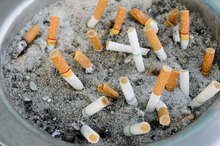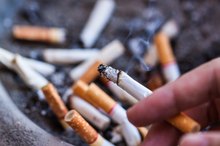What does fact checked mean?
At Healthfully, we strive to deliver objective content that is accurate and up-to-date. Our team periodically reviews articles in order to ensure content quality. The sources cited below consist of evidence from peer-reviewed journals, prominent medical organizations, academic associations, and government data.
The information contained on this site is for informational purposes only, and should not be used as a substitute for the advice of a professional health care provider. Please check with the appropriate physician regarding health questions and concerns. Although we strive to deliver accurate and up-to-date information, no guarantee to that effect is made.
What Happens If You Don't Inhale Cigarette Smoke?
Although there are differences between inhaling and not inhaling cigarette smoke, there is no level of cigarette-smoke exposure that can be considered safe or safer. Whether firsthand (taking a drag from a cigarette) or secondhand (being near someone smoking), cigarette smoke has many known negative health effects. According to the American Cancer Society, there are two forms of secondhand smoke: sidestream smoke (smoke that comes from the lit cigarette) and mainstream smoke (smoke exhaled by a smoker) 2. Sidestream smoke has higher carcinogen concentrations and contains smaller particles than mainstream smoke, so the particles make their way into the body's cells more easily.
If you are experiencing serious medical symptoms, seek emergency treatment immediately.
Smoke Contents
Cigarette smoke contains more than 7,000 chemicals. Sixty-nine of those chemicals are carcinogens. Hundreds of the chemicals are considered toxic. Four of the cancer-causing chemicals include formaldehyde (used as embalming fluid), benzene (found in gasoline), polonium 210 (a radioactive compound) and vinyl chloride (used to make pipes). Some of the toxic metals are chromium (used in steel-making), arsenic (used in pesticides), cadmium (used for making batteries) and lead.
- Cigarette smoke contains more than 7,000 chemicals.
- Some of the toxic metals are chromium (used in steel-making), arsenic (used in pesticides), cadmium (used for making batteries) and lead.
Firsthand Effects
Smoking & Shortness of Breath
Learn More
Smoking cigarettes leads to many negative health effects on the body's systems. Smoking causes asthma, emphysema, chronic bronchitis and pneumonia. Smokers come down with respiratory illnesses that are difficult for the body to fight off and are more likely to lead to hospitalization, compared to non-smokers. The circulatory system is affected greatly--examples include heart attacks, strokes and poor blood circulation in the arms and legs, which for diabetics could result in amputation. According to the 2010 Surgeon General Report, smoking impairs the body's immune system and can damage DNA, leading to cancer of the mouth, nose, throat, lung, stomach, pancreas and bladder, to name a few 1. Even smoking an occasional cigarette is harmful.
- Smoking cigarettes leads to many negative health effects on the body's systems.
- The circulatory system is affected greatly--examples include heart attacks, strokes and poor blood circulation in the arms and legs, which for diabetics could result in amputation.
Secondhand Effects
The more secondhand smoke you are exposed to, the higher the level of these harmful chemicals in your body. Children exposed to secondhand smoke have higher incidences of Sudden Infant Death Syndrome (SIDS), ear infections, asthma and lung infections. For a developing fetus, secondhand smoke can cause low birth weight, miscarriage, pre-term delivery and underdeveloped lungs 3. Children whose mother smoked during pregnancy learn more slowly and perform less well in school. Children and adults exposed to secondhand smoke miss more school and work days and are hospitalized or visit the doctor more often. They are also at risk for high blood pressure, heart disease and cancer.
- The more secondhand smoke you are exposed to, the higher the level of these harmful chemicals in your body.
- Children and adults exposed to secondhand smoke miss more school and work days and are hospitalized or visit the doctor more often.
Not Inhaling
10 Reasons Why Smoking Is Bad
Learn More
Not inhaling while smoking can reduce the amount of nicotine absorbed by the body, and possibly reduce the nicotine dependence on cigarettes. It is also possible that not inhaling exposes the lungs to fewer toxins, but this cannot be confirmed. The American Cancer Society warns that wherever smoke touches living cells, it does harm 2. Smokers who don't inhale are still breathing secondhand smoke, which puts them at risk for many health problems 3. Smokers who don't inhale but put tobacco to their lips or smoke in their mouths are at an increased risk of oral cancers such as lip, mouth and tongue cancer.
- Not inhaling while smoking can reduce the amount of nicotine absorbed by the body, and possibly reduce the nicotine dependence on cigarettes.
- Smokers who don't inhale but put tobacco to their lips or smoke in their mouths are at an increased risk of oral cancers such as lip, mouth and tongue cancer.
Related Articles
References
- A Report of the Surgeon General: How Tobacco Smoke Causes Disease
- The American Cancer Society: Learn About Cancer
- Centers for Disease Control: Secondhand Smoke
- American Cancer Society. Health risks of secondhand smoke. November 13, 2015.
- Centers for Disease Control and Prevention. Secondhand smoke (SHS) facts. January 17, 2018.
- American Lung Association. Health effects of secondhand smoke. March 13, 2019.
- Liu Q, Zhao M, Chen W, et al. Mainstream cigarette smoke induces autophagy and promotes apoptosis in oral mucosal epithelial cells. Arch Oral Biol. 2020;111:104646. doi.10.1016/j.archoralbio.2019.104646
- Yang G, Ibuki Y. Cigarette sidestream smoke delays nucleotide excision repair: inhibited accumulation of repair proteins at DNA lesions. Carcinogenesis. 2018;39(1):56-65.doi:10.1093/carcin/bgx109
- Bhat TA, Kalathil SG, Bogner PN, et al. Secondhand smoke induces inflammation and impairs immunity to respiratory infections. J Immunol. 2018;200(8):2927-2940.doi:10.4049/jimmunol.1701417
- Strzelak A, Ratajczak A, Adamiec A, Feleszko W. Tobacco smoke induces and alters immune responses in the lung triggering inflammation, allergy, asthma and other lung diseases: A mechanistic review. Int J Environ Res Public Health. 2018;15(5).doi:10.3390/ijerph15051033
- Environmental Protection Agency. Indoor air quality (AIQ). Updated December 10, 2018.
- Giotopoulou GA, Stathopoulos GT. Effects of inhaled tobacco smoke on the pulmonary tumor microenvironment. Adv Exp Med Biol. 2020;1225:53-69.doi:10.1007/978-3-030-35727-6_4
- Lima LL, Cruz CMS, Fernandes AGO, et al. Exposure to secondhand smoke among patients with asthma: a cross-sectional study. Einstein (Sao Paulo). 2020;18:eAO4781.doi:10.31744/einstein_journal/2020AO4781
- Diamanti A, Papadakis S, Schoretsaniti S, et al. Smoking cessation in pregnancy: An update for maternity care practitioners. Tob Induc Dis. 2019;17:57.doi:10.18332/tid/109906
- Centers for Disease Control and Prevention. Surgeon general's advisory among e-cigarette use among young adults. 2018.
- smokefree.gov. Using nicotine replacement therapy.
- Centers for Disease Control and Prevention. Health effects of secondhand smoke. Updated February 27, 2020.
- American Cancer Society. Health Risks of Secondhand Smoke. 2019.
- American Lung Association. Health Effects of Secondhand Smoke. 2019.
- Centers for Disease Control and Prevention. Vital Signs: Disparities in Nonsmokers' Exposure to Secondhand Smoke — the United States, 1999-2012. Morbidity and Mortality Weekly Report. February 6, 2015; 64(4):103-8.
- Surgeon General Advisory. E-Cigarettes and Young People. 2019.
Writer Bio
Janice Milliman began writing professionally in 2005. As an addiction counselor, she regularly contributes to the Alere Wellbeing company blog. Milliman received a Bachelor of Arts in social work from the University of Washington.









